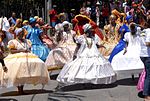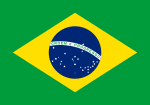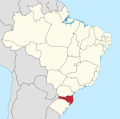and caboclos. Reflecting Umbanda's growth, in 1939 de Moraes formed an Umbandist federation and in 1941 held the first Umbandist congress. Umbanda gained...
91 KB (12,357 words) - 19:54, 15 October 2024
and Umbanda. In these religions, they are considered different from the Orishas but are nonetheless revered. In Brazil, the "Day of the Caboclo" (Dia...
7 KB (759 words) - 00:50, 22 September 2024
Candomblé (section Exus and caboclos)
lesser spirits like the caboclos in the home. Where an individual has come to Candomblé via another Brazilian tradition like Umbanda, they are sometimes deemed...
91 KB (12,310 words) - 19:55, 27 October 2024
Zélio Fernandino de Moraes (10 April 1892– 3 October 1975) was a Brazilian medium who is considered the announcer of the Umbanda religion. He was born...
2 KB (213 words) - 17:16, 13 March 2024
the basis for a number of religions in the New World, notably Santería, Umbanda, Trinidad Orisha, and Candomblé. Yoruba religious beliefs are part of Itàn...
56 KB (3,838 words) - 22:22, 31 October 2024
Jarê (section Pai-de-santo/Curador)
is a private consultation in which the curador/pai-de santo ("healer") with his incorporated caboclo, identifies the nature and causes of the problem experienced...
12 KB (1,755 words) - 17:58, 10 July 2024
1908 - Manifestation of the Caboclo of the Seven Crossroads through medium Zélio Fernandino de Moraes, giving rise to Umbanda in Brazil 1908 - Publication...
13 KB (1,519 words) - 08:17, 6 September 2024
Os Afro-sambas (category Vinicius de Moraes albums)
de Moraes. "Canto de Ossanha" - 03:23 "Canto de Xangô" - 06:28 "Bocoché" - 02:34 "Canto de Iemanjá" - 04:47 "Tempo de amor" - 04:28 "Canto do Caboclo...
5 KB (440 words) - 23:29, 3 April 2024
DE MINA E UMBANDA: O culto aos caboclos no Maranhão". GPMINA (39). Motta, Roberto (1998). "O ÚTIL, O SAGRADO E O MAIS-QUE-SAGRADO NO XANGÔ DE PERNAMBUCO"...
30 KB (2,877 words) - 18:53, 26 July 2024
Demographics of Brazil (redirect from Demografía de Brasil)
cultist/Umbanda 1.8% Other 3% Agnostic/atheist 0.6% None 13.6% Unspecified 1.4% (2023 est.) Race and ethnicity in Brazil Demographics of Rio de Janeiro...
152 KB (11,506 words) - 07:13, 2 November 2024
9%), 37,974 Jehovah's Witnesses (0.6%), 75,075 Buddhists (0.2%), 52,213 Umbanda (0.8%), 21,800 Jews (0.3%), 25,743 Brazilian Catholic Apostolic Church...
230 KB (20,511 words) - 15:08, 27 October 2024
History of spiritism in Brazil (section Umbanda)
first took place in Niterói, with the establishment of Umbanda, traditionally initiated by the Caboclo das Sete Encruzilhadas (1908), and the second occurred...
70 KB (9,695 words) - 21:22, 17 October 2024
could also mean the child of a caboclo and a white person, equivalent to the Spanish castizo, or to the child of a caboclo and an Indigenous person, equivalent...
14 KB (1,657 words) - 22:55, 30 October 2024
such as mulatos and cafuzos, as well as assimilated Amerindians known as caboclos, mixed with Southern Europeans or not. The term "pardo" was first used...
41 KB (4,542 words) - 14:28, 15 October 2024
scarcely one and a half meters, who has spent more than forty years in Umbanda, twenty-one in Candomblé, and eighteen years in Santo Daime. Despite her...
17 KB (2,436 words) - 09:56, 15 October 2024
and nobles, like King Sebastian of Portugal, King Manoel, King Luís) or caboclos (if they are of native origin, or Turcos of moorish kings origin, or indigenous...
13 KB (1,460 words) - 14:31, 5 October 2024
Candomblé and Umbanda, with aggressive speech and attacks on temples. In 2005, a Brazilian court ordered that Macedo's book Orixás, Caboclos e Guias: Deuses...
80 KB (9,175 words) - 18:57, 25 October 2024
portion, particularly in Umbanda. These religions are mainly practiced in large urban centers such as Salvador, Recife, Rio de Janeiro, Porto Alegre, Brasília...
92 KB (9,476 words) - 20:32, 1 November 2024
Kardecist Spiritism, and African-Brazilian religions such as Umbanda, Candomblé and Tambor de Mina, later expanding to several countries across all continents...
91 KB (9,997 words) - 08:38, 22 October 2024
Portuguese, also colloquially moreno) is a broad category that includes caboclos (assimilated Amerindians in general, and descendants of Whites and Natives)...
288 KB (25,351 words) - 01:30, 2 November 2024
verification] In Brazil, people of White/Indian ancestry are historically known as caboclos or mamelucos. They predominated in many regions of Brazil. One example...
32 KB (3,387 words) - 21:50, 23 October 2024
discrimination against the Europeans who married them, banning the use of the term caboclo, a pejorative used to refer to a mestizo or a detribalized indigenous person...
108 KB (14,188 words) - 04:15, 2 November 2024
such as the reduction of the indigenous population, the increase of the Caboclo identity, the mixing of whites, blacks and indigenous people, the reduction...
21 KB (1,837 words) - 05:39, 2 November 2024
(Portuguese: mestiço). The term denotes a broad category which includes caboclos (descendants of whites and Indians), mulattoes (descendants of whites and...
130 KB (15,756 words) - 08:44, 13 October 2024
were classified by their owners. ^3 The 1872 and 1890 censuses counted "caboclos" (White-Amerindian mixed race people) apart. In the 1890 census, the category...
202 KB (19,185 words) - 18:58, 1 November 2024
(0.08%), Esoteric traditions (0.03%), Judaism and Islam (0.03% each), Umbanda (0.02%) and Hinduism (0.01%). The Roman Catholic Diocese of Roraima with...
73 KB (7,618 words) - 20:18, 18 October 2024
Black Culture in Brazil. The Batuque in Umbanda: Symbolism, Ritualismo, Interpretation. Leopoldo Battiol, Rio de Janeiro, ed Aurora, 1963. Hess, D.J. (1991)...
53 KB (6,333 words) - 16:32, 2 November 2024
disagreement between the two federative units and the armed conflict of the caboclos only ended completely in 1916. Santa Catarina's territory was invaded by...
93 KB (9,201 words) - 06:35, 25 October 2024
Latvian, Japanese, Finnish and Estonian, Belarusian, Slovene, Ashkenazi Jew, Caboclo, British, Czech, Slovak, Belgian and Hungarian Southern Brazil has subtropical...
40 KB (4,001 words) - 01:48, 18 September 2024
African altogether combination is the most prevalent one, followed by caboclo, mulato and zambo. According to the 2010 census, the population of Paraíba...
66 KB (6,564 words) - 18:12, 10 October 2024























